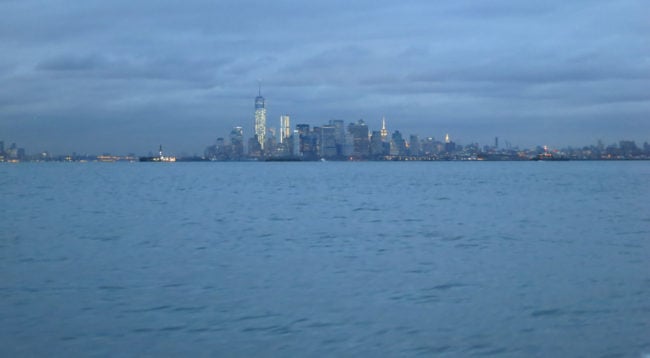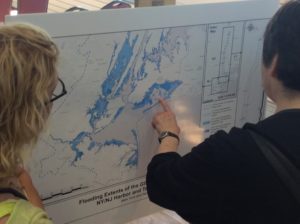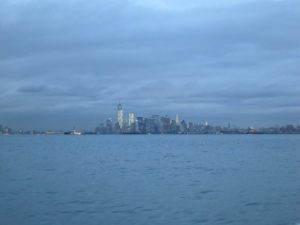UPDATE: Army Corps yields to demand for more time & transparency on NY Harbor storm surge barrier plans

View more images on our Flickr site
After months of public pressure, the U.S. Army Corps of Engineers has agreed to allow more time and transparency before advancing any of its flood protection plans for New York Harbor – many of which threaten to permanently damage the Hudson and leave communities vulnerable to rising sea level.
The Corps announced this month that it would revamp the timeline for its NY/NJ Harbor storm surge barrier study and hold off until Spring 2020 before narrowing down the six current options to one or two. That step – one that will have enormous consequences – was originally slated to be rushed through this Fall. The Corps will also produce an interim report in early 2019 that could offer the first real details about the six plans. [Update:] The Corps plans to release the interim report February 19 and hold public meetings in March and April 2019.
 Activated and informed by Riverkeeper, thousands of individuals, numerous environmental groups, elected officials and at least 17 Hudson Valley communities have demanded more time, information and public participation since the Corps presented the six options to the public in July with barely any notice.
Activated and informed by Riverkeeper, thousands of individuals, numerous environmental groups, elected officials and at least 17 Hudson Valley communities have demanded more time, information and public participation since the Corps presented the six options to the public in July with barely any notice.
We’ve made some progress. First we won two extensions of the public “scoping” comment period, which currently runs through November 5. Now we’ve gained some improvements in the timeline and a promised interim report. The New York City Council is considering its own resolution at a hearing on October 22. The Corps has just scheduled a public meeting in Long Island on October 23.
The scale of this project is simply enormous, and so are the potential impacts – particularly from in-water barriers that would choke off the tidal flow of the Hudson River Estuary and the migration of fish. Given the potentially devastating effects, and the lack of any specifics whatsoever, the Corps’ initial timeline was an absolute outrage.
The Corps’ public notification process has been abysmal, almost ensuring that very few people would be involved in the discussion. We have done our best to bring transparency. National groups like Waterkeeper Alliance and NRDC joined our campaign to oppose the in-water barriers and demand meaningful public involvement.
We have learned that New York State has been influential behind the scenes, helping to persuade the Corps to make these improvements to the process. That intervention is very much appreciated. We expect the state Department of Environmental Conservation to take a public and active role in fostering fully-inclusive community participation and full consideration of sea level rise in this process – and to protect our communities, our economy, and our environment against any ill-conceived storm surge barrier plans.
We must clearly voice our shared interest in a rational, comprehensive approach to coastal protection – an approach that plans for the long term, protects us from both storms and sea level rise, and does not cause harm to the life of New York Harbor, Long Island Sound, and New York’s jewel, the Hudson River.
Learn more at Riverkeeper.org/barriers and send a message to the Corps by November 5.
More details: What’s new in the storm surge barrier study?
-
-
- Selection of plans. Instead of “winnowing down” the six conceptual plans in November 2018, the Corps has postponed that pre-selection step to Spring 2020. This will enable the public to better research the environmental and community consequences of in-water barriers, a feature in four of the plans (Alternatives 2, 3A, 3B and 4) and the advantages of shoreline measures (Alternatives 1 and 5).
- Interim report. The Corps will produce an “interim report” in early 2019 with additional detail on the six alternatives and a preliminary analysis of their relative costs and benefits. The Corps said during its October 3 meeting at the Westchester County Center that it would share some studies used in the preliminary analysis. This is significant: The preliminary cost benefit analysis and shared studies would be the first actual substance – hard data and design details – that the public could use for its own analysis.
- Public meetings. The Corps said it would hold a number of meetings in 2019 to gather feedback on the interim report, and release a Draft Feasibility Report / Tier 1 Environmental Impact Statement in Spring 2020 on its “tentatively selected plan(s).” The rest of the timeline is unchanged: A “Chief’s Report” is still due in Summer 2022, followed by a recommendation to Congress. Should a project be authorized for construction, money would be appropriated and the project would be designed in more detail.
- Storm surge barriers. The bad news is that for the time being, all six alternatives, including the four that include in-water barriers, are still on the table. In-water barriers of any kind would be extraordinarily detrimental to our rivers, New York Harbor and the Hudson. And with gates kept mostly open for ships to pass, they would not protect New York City or our communities from sea level rise in the long term. See this post for more.
- Cost of barriers. Without explanation, the Corps raised the cost estimate for the most drastic alternative, which includes a 5-mile storm surge barrier from Sandy Hook, N.J., to Breezy Point, N.Y. (Alternative 2). The Corps’ earlier estimate was $30 to $50 billion; now it’s $140 billion. Bryce Wisemiller, project manager, said although the cost may be $140 billion, the “benefit” (or value of assets protected in a storm) could turn out to be $200 billion.
- Environment. The Corps reiterated that it would only use a cost-benefit analysis to decide which option or options to advance. This formula places zero value on so-called “ecosystem services” – the vital, unique, complex and interconnected web of life in New York Harbor and Hudson. Instead, the Corps will weigh the cost of potential structures against the value of real estate and infrastructure that these structures are expected to protect in a storm. We must do better.
- States’ role. Although the Army Corps’ feasibility study is governed by procedural rules limited to cost-benefit analysis, New York State is not restricted from using its own environmental laws, rules and regulations, in the assessment of the relative impacts of alternatives. The Corps needs the support of its “non-federal sponsors” – including New York’s DEC – to move the project forward.It will be up to New York State to protect the Hudson, New York Harbor and the other waterways that meet the Atlantic there.
-

